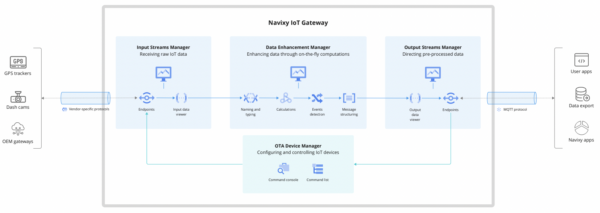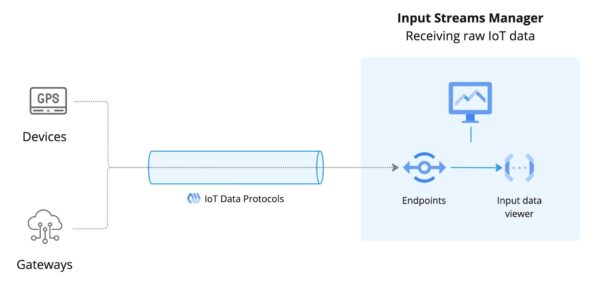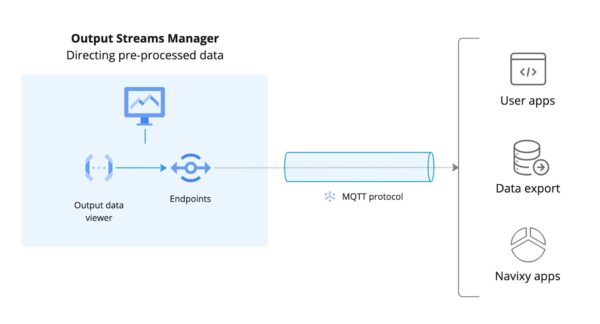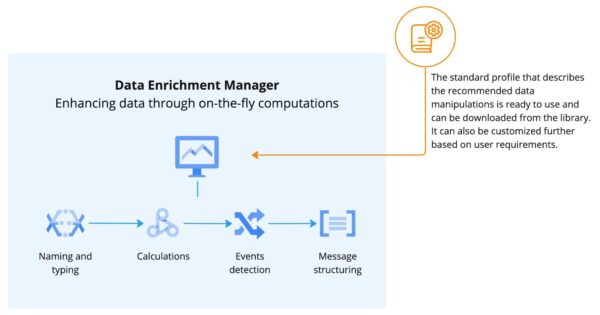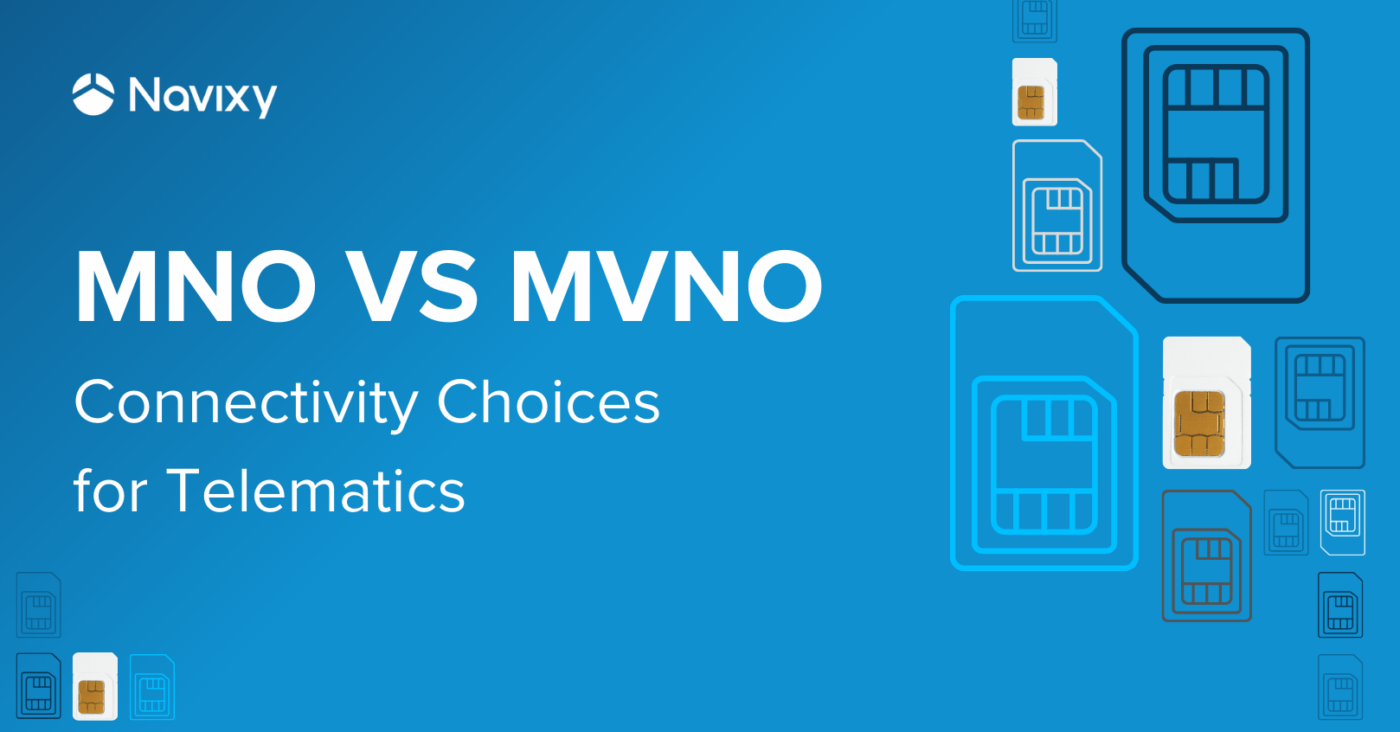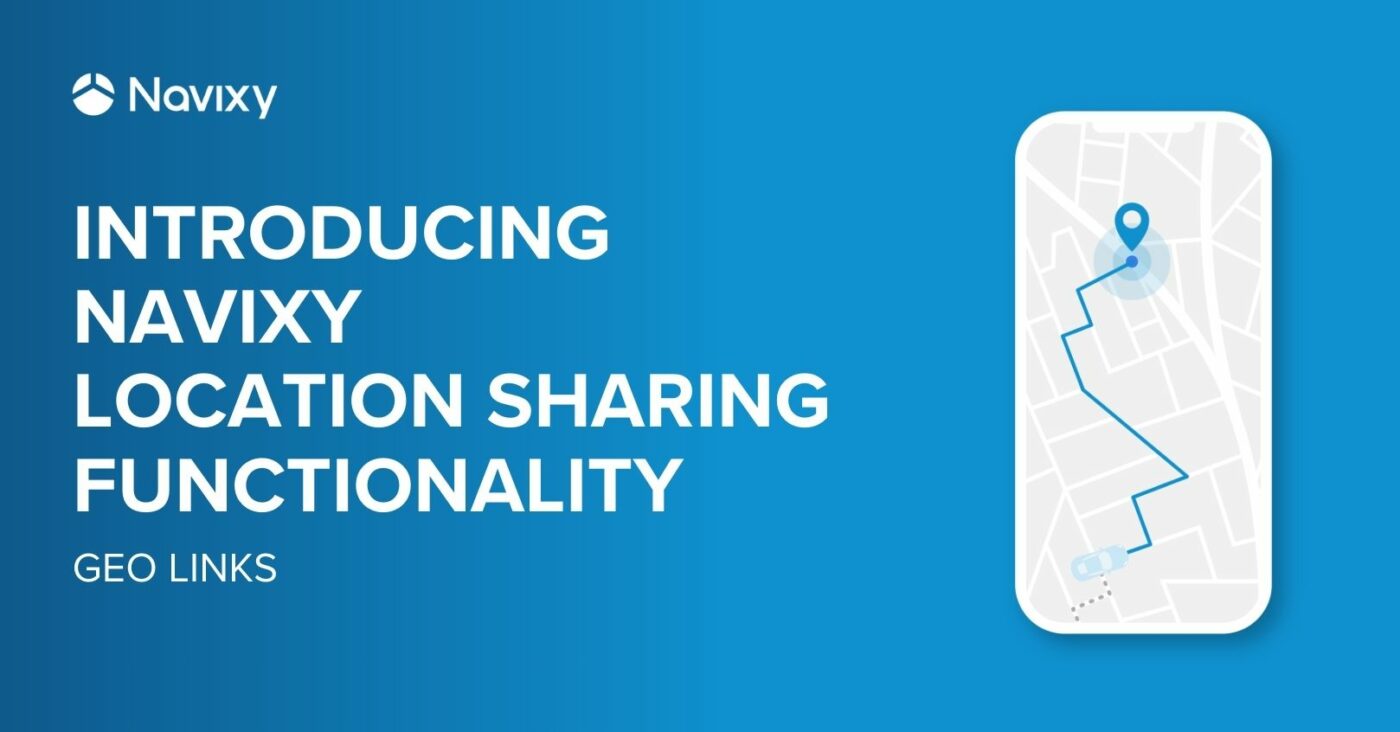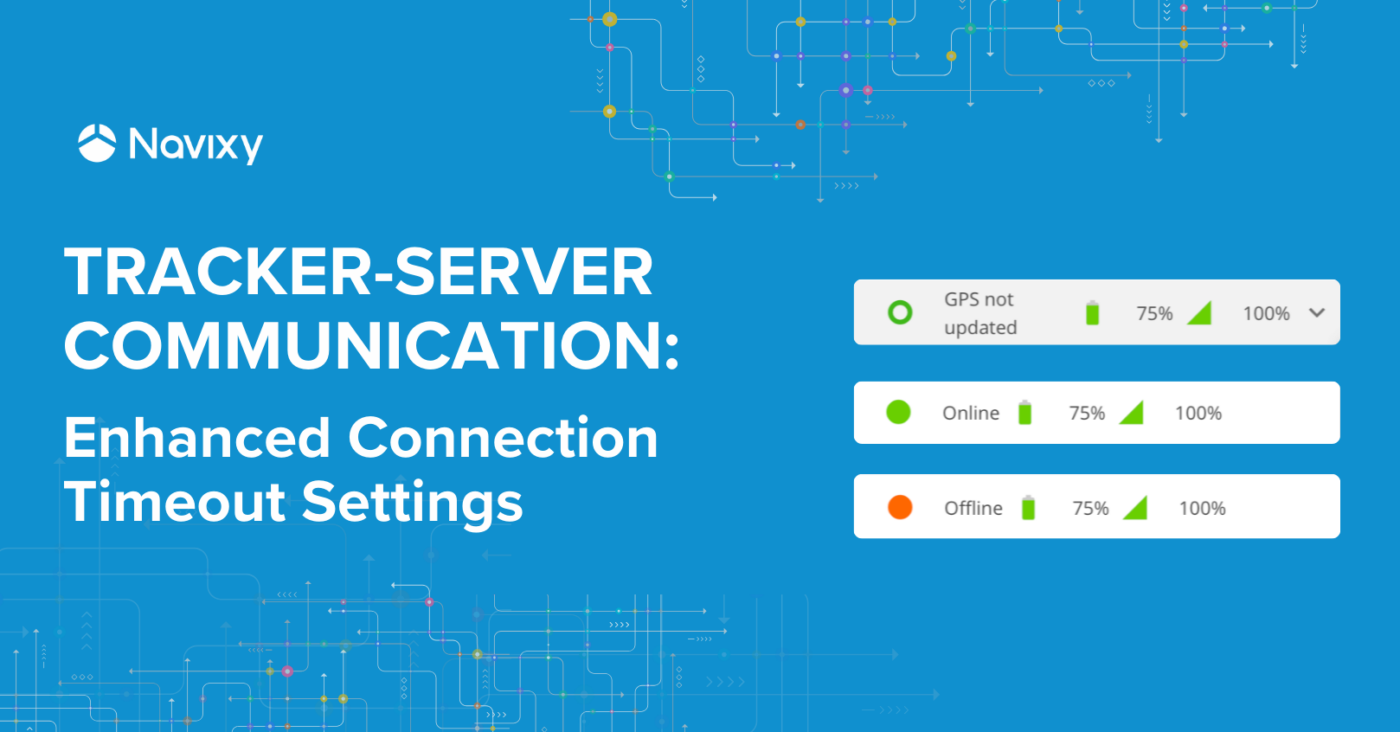One of the biggest challenges developers face is integrating devices from different manufacturers. Since vendors often use various protocols and types of data, it takes time and resources to ensure they can work together in the same IoT ecosystem. Fortunately, with the Navixy IoT Gateway, it’s quick, easy, and cost-effective to integrate a wide variety of devices in a streamlined manner.
In this post, we’ll explain how our IoT Gateway helps developers streamline device integration and data processing, as well as how users can manage every stage of the input and output data streams for valuable data-driven insights.
What is Navixy IoT Gateway?
The Navixy IoT Gateway is a powerful software product designed to collect, enhance, and transmit data from various vehicle telematics devices to higher-level applications.
The gateway acts as a bridge between different data sources, including GPS tracking devices, vehicle telematics devices, and OEM gateways that connect IoT devices operating within private networks such as satellite or LPWAN.
The primary function of the Navixy IoT Gateway is to facilitate seamless integration of diverse devices from different vendors. By unifying the protocols of various devices, it enables higher-level applications to access the functionality of various telematics devices in a versatile manner. This device-agnostic approach eliminates compatibility issues and streamlines the development process for application developers.
The Navixy IoT Gateway goes beyond simple data collection and offers powerful data enhancement capabilities. It enables on-the-fly calculations and the application of boolean logic operators to complement edge logic with server-side logic. The gateway also organizes the output data streams in a developer-friendly manner, making it convenient for developers of higher-level applications to process the data.
Additionally, the gateway provides comprehensive configuration and control features for IoT devices over-the-air (OTA). It supports preset, custom, and manual commands, empowering users to remotely manage and monitor their IoT devices. The logging functionality ensures detailed record-keeping for command executions, enabling easy tracking and analysis.
In summary, the Navixy IoT Gateway is a robust solution that seamlessly connects diverse telematics devices, unifies protocols, enhances data, and offers extensive control capabilities. It simplifies the integration process for application developers, allowing them to focus on building innovative solutions on top of a reliable and versatile foundation.
Input data stream
The IoT data is received from devices either connected directly or through network gateways. The messaging protocols for IoT data can be vendor-specific, but JSON or Protobuf are recommended options. Lower-level packets can be transmitted using protocols such as TCP, UDP, HTTP, and MQTT.
The Navixy IoT Gateway supports protocols from all major manufacturers of vehicle and asset tracking devices. However, if you're planning to integrate your own device or gateway, we recommend using JSON or Protocol Buffers (Protobuf). By doing so, you can seamlessly integrate your device without any additional integration effort, and you will be able to instantly operate with the data.
Output data stream
The Output Data Stream is a key deliverable of the Navixy IoT Gateway. It encompasses relevant data and information that is specifically tailored for user applications. This data is presented in the form of messages that are easily consumable and convenient for application integration.
Each message within the output stream is structured with groups of parameters that are organized into five distinct batches: Location, Network, Device, Telemetry, and Logic. This categorization is implemented to enhance the convenience of application development, but it is not mandatory. Any parameters that do not fit into these defined categories are included in the Uncategorized group to ensure their inclusion and availability.
To facilitate efficient and reliable transmission, the messages in the output stream are transmitted using the MQTT protocol. MQTT offers a lightweight and efficient communication mechanism, optimizing the delivery of data from the Navixy IoT Gateway to the intended recipients.
Managing IoT Gateway
Now, let's delve into a detailed examination of each stage of data and command processing within the Navixy IoT Gateway.
At a higher level, the Navixy IoT Gateway comprises four components:
- Input Streams Manager
The Input Streams Manager is responsible for receiving data from various sources such as GPS tracking devices, vehicle telematics devices, and OEM gateways. It efficiently manages the incoming data streams, ensuring proper handling and processing. - Data Enhancement Manager
The Data Enhancement Manager plays a key role in enhancing the received IoT data. It applies calculations, logical operations (such as IF..THEN statements), and server-side logic to augment the raw data in real-time. This enables the Gateway to enrich the data before it is passed on to higher-level applications. - Output Streams Manager
The Output Streams Manager handles the transformed and enhanced data, directing it to the intended destinations. These destinations can include user applications, Navixy applications, and data exporting tools. The Manager ensures that the data is efficiently transmitted to the appropriate endpoints, facilitating seamless integration with the target systems. - OTA Device Manager
The OTA Device Manager enables over-the-air (OTA) configuration and control of IoT devices. It supports various types of commands, including preset, custom, and manual commands, allowing users to remotely manage and control their IoT devices. Additionally, the OTA Device Manager maintains detailed logs of command execution for effective tracking and analysis.
These four components work in tandem to ensure efficient data processing, enhancement, and transmission within the Navixy IoT Gateway. By effectively managing input and output streams, applying data enhancement techniques, and enabling remote device management, the Gateway empowers users to harness the full potential of their IoT ecosystem.
Input streams manager
The Input Stream Manager streamlines IoT device connections and facilitates the analysis of raw data. It performs two primary functions: configuring endpoints for device connections and granting engineers access to the incoming IoT data.
The Endpoints Configurator enables the configuration of endpoints to connect specific types of IoT devices. For instance, an endpoint can be set up to accommodate GPS trackers from a particular vendor, model, and firmware version. Another use case is configuring an endpoint to receive data from OEM gateways that facilitate the connection between devices operating in private networks and applications in public networks.
- The user interface of the Input Stream Manager enables the configuration of endpoints to receive data from various sources in vendor-specific formats and through different transport protocols, including TCP, UDP, MQTT and HTTP. It supports public Internet or VPN connections, with or without encryption.
- Users can create multiple endpoints if they have several data sources or if they need to process data streams from the same source in different ways.
- In cases where IoT devices are controlled via SMS from a server, it is possible to configure an additional endpoint with SMS centers (SMSC). This endpoint will be used to handle M2M commands and responses sent through text messages.
The Input Data Viewer enables integration and technical support specialists to monitor raw data from IoT devices. They can apply filters based on parameters such as data field names and device ID to ensure the reception of expected and accurate raw data. Additionally, the tool provides the capability to log and save the data to a file for further analysis and reference.
Data enhancement manager
In this section, we will describe the Data Enhancement Manager (DEM), a tool that facilitates no-code data manipulations to prepare data for utilization in user applications. These manipulations encompass pre-processing techniques aimed at enhancing and enriching the data, including:
Data transformation:
- Applying mathematical functions, text string manipulations, or bit masking.
- Performing complex data modeling tasks such as interpolation, extrapolation, data smoothing, or time series forecasting.
Data cleaning:
- Removing irrelevant values by applying threshold-based or other logical filtering to eliminate data points that do not meet specific criteria.
Data encoding:
- Converting data into appropriate formats for seamless transmission and processing within user applications.
- Encoding categorical variables, standardizing timestamps, or transforming data into binary representations.
Server-side conditional logic:
- Employing dynamic decision-making and automating actions based on conditions or events within the data. For instance, utilizing IF...THEN statements to trigger actions, such as sending information about specific events.
For the IoT device models that are already integrated with Navixy, the recommended data manipulations are pre-configured. This is accomplished through standard DEM profiles available in the library, which describe the suggested manipulations. This simplifies the process of setting up endpoints, making it convenient for users. Moreover, customization of the standard data manipulations is also possible, enabling users to save custom profiles for reuse with additional endpoints.
When a user integrates fundamentally new data sources, such as a recently released IoT device or a custom IoT data gateway, they are required to create a new DEM profile for that source from scratch. Navixy certified manufacturers have the option to publish their recommended DEM profiles in the library, which simplifies the process of setting up endpoints for their customers.
Fields naming
Users can label the fields for IoT data that will be utilized in applications. It is advisable to use meaningful labels that adhere to best practices observed when working with tables in databases or programming. A label should be descriptive, concise, and accurately reflect the nature of the data it represents.
For example, labels in the standard DEM profiles are presented in the form of lowercase alphanumeric strings without spaces, using underscores to separate words (e.g., "device_id", "temperature_sensor", "latitude"). These labels are intuitive and enable easy referencing of the data within applications. The following document describes common labels in DEM profiles as recommended by Navixy.
Fields mapping
Users have the ability to map fields from the input stream, which contains raw IoT data, to the fields defined in the DEM profile. The mapping links can have three types:
- field-to-none – indicating no mapping;
- field-to-one – mapping one field to another;
- field-to-many – mapping one field to multiple fields.
Fields typing
Defining the field types is essential for efficient data processing and manipulation. By specifying the appropriate data type for each field, users can apply operations that are specifically tailored to the corresponding data types. This ensures accurate handling of integers, floats, booleans, strings, dates and times, coordinates, and blobs, enabling precise transformations and enhancing the overall quality and usefulness of the data within the system.
Output streams manager
The Navixy IoT Output Streams Manager enables the handling of the transformed and enhanced data and directs it to the intended destinations. This component ensures the efficient transmission of the processed data to the appropriate endpoints, facilitating seamless integration with the target systems.
To view and analyze the output data stream generated by the gateway, there is a tool called the Output Stream Viewer. It provides a user-friendly interface where integration and technical support specialists can observe the structured messages and parameters within the output stream in real-time. This tool allows users to ensure that the data is properly prepared and available within integrated applications.
Conclusion
The Navixy IoT Gateway offers product developers and system integrators a powerful solution for integrating and harnessing the potential of telematics data. It effectively bridges the gap between diverse data sources, allowing for seamless integration and access to telematics data. With its ability to receive and process IoT data from various devices, unify protocols, enhance data quality, and provide comprehensive control features, the gateway simplifies the development process and empowers users to build innovative applications on top of a reliable and versatile foundation.
With the Navixy IoT Gateway, integration of telematics devices becomes quick, easy, and cost-effective. It seamlessly feeds data from any telematics device to a wide range of systems, including user applications, analytics software, and Navixy's comprehensive suite of tools. This enables the development of robust, scalable, and device-agnostic telematics solutions that cater to specific business needs. The gateway serves as a solid foundation for building advanced telematics applications that unlock the full potential of data-driven insights.
Create an account today to experience more of what Navixy has to offer.
